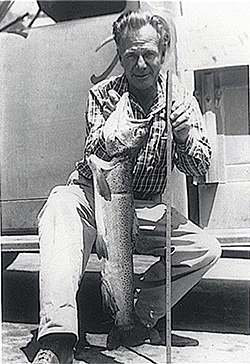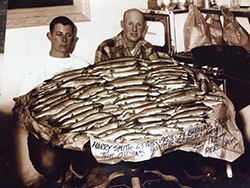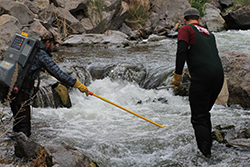
Faded black and white photos are all that’s left of the Owens River Gorge’s glory days as a trophy brown trout fishery. Biologists expect the fish to make a comeback following near-annual pulse flows that begin in September to improve habitat.


CDFW crews electrofish the Owens River Gorge two times per year to assess the health of the river’s brown trout.
From boom to bust to decades of angler indifference, few California fisheries have experienced such wild swings of fortune as Mono County’s Owens River Gorge.
The latest chapter in the long saga of the Gorge unfolds this month when the Los Angeles Department of Water and Power (LADWP) sends a relatively brief burst of water known as a “Channel Maintenance Flow” down the 10-mile stretch of river between the Upper Gorge Power Plant and Pleasant Valley Reservoir to benefit fish habitat.
From Sept. 9 to Sept. 17, water flows will rise from the relatively placid 35 to 55 cubic feet per second (cfs) typical in the Gorge to 680 cfs before gradually ramping back down.  Access to the Gorge will be closed by LADWP during the nine-day “pulse flow” event for public safety.
Access to the Gorge will be closed by LADWP during the nine-day “pulse flow” event for public safety.
The temporary boost in water flow represents the successful resolution of decades of legal battles involving LADWP, Mono County and CDFW. The high flows are expected to breathe new life into the Owens River Gorge ecosystem and its once-storied brown trout fishery. Court settlements mandate the pulse flows continue almost annually -- 18 out of every 20 years.
The flows are intended to replicate seasonal scouring that occurred naturally in the Gorge long before dams, power plants and water diversions were constructed in the last century. In fact, these alterations dried up the Owens River Gorge from 1953 to 1991 until years of litigation restored some minimal flows and attempts to restart a once-fabled brown trout fishery.
The Owens River Gorge is paradoxical – so close yet so far away. Just northwest of Bishop and within sight of Highway 395, it is difficult to access with limited and steep trails to reach its waters 500 to 900 feet below the rim. Since water returned to the Owens River Gorge in 1991, it has been more popular with hikers and rock climbers than trout anglers.
It was a much different story prior to the construction of the Long Valley Dam in 1941, which created Crowley Lake, and the subsequent addition of a number of power plants along the stretch of river. Before then, the Owens River Gorge was a destination brown trout fishery with a worldwide reputation. So good was the fishing it was one of the few waters in California with limits based on weight – 25 pounds plus one fish per angler per day.
CDFW Environmental Scientist Nick Buckmaster is based in Bishop and conducts twice-yearly electrofishing surveys in the Gorge along with macroinvertebrate sampling.
“Right now, the fish populations are pretty stunted,” Buckmaster said. “We just don’t have large brown trout in the Gorge anymore.”"
The Gorge is home almost exclusively to wild brown trout and the populations are high. Buckmaster estimates between 1,500 to 5,000 trout per mile, numbers that compare favorably to many blue-ribbon trout fisheries in the state.
“The problem is they are all small. Their growth really slows down around 5 inches, and most of the fish in the Gorge are less than 8-inches long. Their growth really plateaus,” he said. “By the time they get to 8 inches, they are geriatric fish.”
Buckmaster explained that brown trout undergo an important life change once they reach between 8 and 14 inches in size. They mostly stop eating aquatic insects and transition into apex predators, preying on other fish and just about anything else of substance they can eat. The diet change leads to rapid growth and turns them into a prize for any trout angler skilled enough to catch them.
Plateauing at 5 inches, however, most of the brown trout in the Owens River Gorge never reach that important developmental milestone or achieve it only toward the end of their lives.
“If you want big brown trout, they need something to eat,” Buckmaster said. “And they usually need a lot of something to eat.”
CDFW fisheries biologists expect the pulse flows to provide just that by dramatically altering the ecosystem. The big burst of water will scour pools and restore the deep-water holding and ambush habitat needed by large brown trout. The flows will flush out years of accumulated sediment, exposing gravel beds critical for trout breeding while fostering a broader diversity of aquatic life than what’s present in the Gorge today.
Mayflies and stoneflies are largely absent from the ecosystem, and caddisflies – safely encased and underneath rocks in their larval stages – provide a limited food source. Small populations of native Owens suckers exist in the Gorge. Their numbers are expected to grow with an increase in aquatic insect life following the pulse flows, incidentally providing important forage for growing brown trout.
The high waters will inundate and benefit riverside riparian growth, offering shade and cover and additional insect habitat. The flows also are expected to flush out invasive New Zealand mud snails that have infested the Gorge over time. The snails provide little benefit to fish and are a source of competition for other macroinvertebrate life.
Buckmaster said biologists could see positive changes in the Gorge as quickly as three months after the flows. And bigger brown trout could start turning up in Buckmaster’s electrofishing surveys – and at the end of anglers’ lines – as early as next year.
CDFW Photos. Top Photo: CDFW scientific aids Christi Kruse and Emma Hewitt identify some of the macroinvertebrate life taken from the Owens River Gorge.